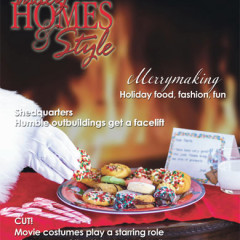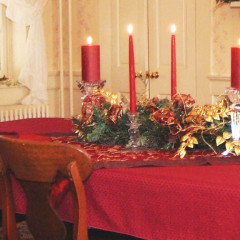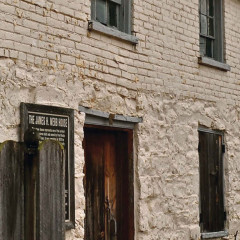Valley Homes & Style Magazine | December 2015 – January 2016 Edition
December 2015 – January 2016 Edition
Christmas in Glengary
A tribute to John Morris by Brenda Miller, Designer of Interior Spaces It’s the time of the year when the sights and sounds of the season surround us. The chill in the air, the sound of holiday music, and the glistening of colorful lights. This is the time of the year that brings me back to childhood memories of love and joy. As a designer, this time of the year brings me a busy schedule – it’s time to decorate for clients. For me it’s more than transforming homes and businesses into the “Magic of the Season,” it’s creating friendships, lasting memories and making people smile. The holiday season allows my creative juices to flow. Over the years I have staged and decorated many homes. In life we all have favorites; I want to share one of my favorite homes with you. It may be because of the beautiful winding staircase, the tastefully decorated rooms with high ceilings, the abundance of Christmas décor or the opportunity to decorate FIVE mantles. In truth, it is none of those reasons – it’s my favorite home to decorate because of the homeowners. Their love of the holiday season is evident by the stack of the over 40 tubs of decorations ready for me to display throughout their home, and the excitement expressed when I enter the home each day to decorate. This majestic home of Greek revival style is located just outside of the Stonewall Industrial Park standing on several acres – the home of John and Cheryl Morris. For many years, I have known and become dear friends with John and Cheryl along with their dog Daisy and the two cats, Sweet Pea and Darlin’. Their home, known as Glengary, is rich with history. Originally built in 1831, Cheryl’s father, Douglas O. Grimm, acquired the home March 1956. During the Civil War, the basement was used as a hospital. In the 1900s, her father added the two story “L” frame. Later in the 1970-1990s, the garage, storage room and sun porch were built. The home is over 5,000 square feet and is three stories if you include the attic. As you drive up the driveway toward the home, you cannot miss the beautiful columns out front. Her father had the columns added with an element of surprise. Each column houses a telephone pole which adds to the stability of each one. (Her father had good friends in the telephone company.) There are many wonderful memories in the home and I and the pleasure of talking to Cheryl about the history and traditions still celebrated today. Her father loved cedar trees. For...
Enjoying the Holidays and History in Charles Town, W.Va
Dolley Madison Garden Club hosts Christmas Market and historic Webb-Blessing House event by Katherine Cobb How many places in the country can you find some distinctive holiday gifts and take in a unique historical visit? One place for sure on December 12, when the Dolley Madison Garden Club holds a festive Christmas Market in conjunction with an open house at the nearby historic Webb-Blessing House. The market features a variety of local vendors and artisans, musical performances throughout the day by different school groups, a special gift-making workshop for kids and the Dolley Café selling local fare. It will be open from 10 a.m. to 4 p.m. at the Charles Town Presbyterian Church at 220 E. Washington Street in Charles Town. Products on sale include fiction and nonfiction books, vases and pottery, handcrafted wood-turned items, handknitted creations, hand-painted decorative pieces, vinegars, jewelry, handbags, soaps, garden-related items, greeting cards, Christmas decorations and fresh greenery. As an additional treat, the club is featuring the nearby Webb-Blessing House, which will be artfully decorated by Dolley Madison Garden Club members and is open to visitors during the event. This historically significant home is located at 303 East North Street and currently serves as a museum. The club intends to partner with the Jefferson County Black Historic Preservation Society to restore the backyard to a mid-19th century garden, reflecting what it most likely would have been when the home was occupied. On the National Register of Historic Places, the Webb-Blessing House was originally owned by Samuel Washington (brother of George and Charles). He deeded the lot to Ezekiel Dean in March 1797. In 1829, Dean deeded the property to Isaac and Charlotte Gray, annotated as “persons of color.” Shortly after this transfer, James Webb built a stone house on the property. This is one of the earliest stone structures built by a free black. The Blessing family took up residence in the clapboard house at the end of the Civil War. Blessing was a baker who supplied food to John Brown during his incarceration and befriended him. Another significant aspect of this property is the well that stood in front of the house. In Charles Town’s early days, there were twelve wells strategically placed to provide water for the townspeople; the oldest was in the front of this house. In 2003, the Jefferson County Black Historic Preservation Society purchased the Webb-Blessing House to restore it and establish a museum about this significant structure and its inhabitants. Currently there are two exhibits, one about the Blessing family and another titled, “African American Military from 1812.” The Dolley Madison Garden Club intends to use its proceeds...
Ring Around The World
by Mary Stickley-Godinez Around the holidays, we often adorn our homes with wreaths on our front doors. Did you ever wonder where this tradition came from? It turns out this symbol of Christmas has quite a long history. The earliest known fabricated wreaths in history came from the Etruscans, the civilization that inhabited the Italian peninsula before the Romans. Many graves have been found containing gold wreaths that were worn on the head and depicted leaves and plants. The leader of all the Greek gods was Zeus. The ancient Greeks believed he went into an oak grove to make his most important decisions. Thus the oak wreath symbolized wisdom and judgement. Another myth of the ancient Greeks told of the Sun God, Apollo, who fell in love with Daphne. She was frightened by him and tried to escape his advances. In her terror, she called out to a river nymph for help and he turned her into a laurel tree. Heartbroken at his loss, Apollo wore a laurel wreath on his head from then on. So in Greek culture, the laurel wreath was used to symbolize victory, achievement and status. And it was the coveted prize of the first Olympics. The Romans continued this practice by using the laurel wreath to crown their leaders, victors and heroes. Another wreath, the harvest wreath, was also quite popular throughout pagan Europe. These were predominantly made of woven wheat, but also sometimes used other grains as well as nuts, berries and fruits. Annually, a celebration occurred in which a harvest wreath was marched throughout a town to bring on an abundant harvest and to protect against crop failure and plague. Smaller versions of the harvest wreath were hung on the front door or the gate throughout the year to protect and bring luck to individual homes. It is believed to be the early Lutherans that gave us the Advent Wreath. The legend tells of a devout gentleman who was trying to help his children count the days and weeks before Christmas day. He took a wagon wheel and fixed candles to it. The candles were lit to mark each day with a special one to mark each week. The wheel was a circle, an early symbol of infinity that was also used to explain how the Christian God had no beginning or end. Later versions were adorned with evergreens to depict everlasting life. Over time the Advent Wreath took the place of harvest wreaths on the doors and posts of devout Christians. But the nuts and fruits worked their way into the greens, making them a beautiful tribute to God’s creation. Today...
Zoe’s Candy Canes
Hand pulled the old-fashioned way by Joseph Weagley Pantelis, Zoe and Petros Tsoukatos are third generation chocolatiers who grew up in Waynesboro, Pa. Their father, Chef George Tsoukatos, had worked in the chocolate industry for more than 30 years. While his children grew up around the business, the three never imagined that they would continue another generation in the chocolate industry. After completing their educations, they began their professions in nearby Washington, D.C. However, they soon realized that they missed what was once a constant joy in their lives: the aroma of melting chocolate, the busy excitement during the holiday season and seeing the happy faces of their customers. They also missed working with family. They decided they had a mission. With that decision, their family came full circle. In 2007, Chef George, Pantelis, Zoe and Petros opened their own business in Waynesboro, Pa. They named the company “Zoe” because it means “giving life” in Greek. Chef George and his wife, Elaini, raised their three children with an awareness of fresh, natural and locally grown food. Their culinary knowledge was enhanced by their travels throughout Europe. Together, Chef George and his children create artisan chocolate delights with visionary flavors and extraordinary textures. Their success led to the opening of a second store in Frederick, Maryland a year and a half later. Recognition came when their chocolates were featured in prestigious magazines, including “O: The Oprah Magazine” and “Washingtonian Magazine.” Despite the sophisticated allure of their chocolates, tradition still has a place at Zoe’s Chocolate Company. Co-owner Zoe Tsoukatos explains that as the holiday season approaches, her family looks forward to the production of handcrafted candy canes that are made from a century old family recipe. “The recipe that we use is the same recipe that was used by our grandfather, great aunt and great uncle,” Zoe says, pointing out that they were the first members of the family to come to the United States from Greece. “They made chocolates, and they also started making candy canes.” The process begins at the company’s factory workrooms, behind their storefront, in Waynesboro. Sugar and water are mixed in a copper cooking kettle. Using an antique fire burner that has been in the family for three generations, the mixture is cooked until it reaches the desired temperature. Next, it is poured onto a cooling table. At this point, the amber colored solution looks similar to taffy and it is flipped around on the table until it cools. Then, with gloved hands, the still hot candy is lifted onto a wall mounted steel hook and pulled by hand. “It’s the same hook that was...






